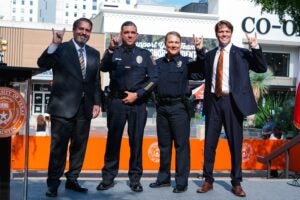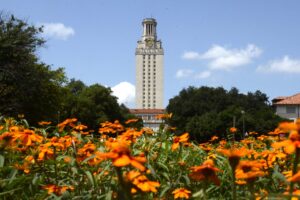AUSTIN, Texas—An elderly person’s excessively slow walking speed may increase the person’s susceptibility to falling, says a University of Texas researcher who is starting a study aimed at averting hip fractures that annually injure more than a quarter of a million people over age 65.
Mechanical Engineering Professor Rick Neptune aims to prevent those traumatic injuries at their source. Neptune, whose research specialty is in biomechanics, recently received a three-year, $232,000 grant from the Whitaker Foundation to study the walking traits that make some elderly more prone to catastrophic falls. His surprising hypothesis: walking speed plays an important role — with an excessively slow gait being an important characteristic of those susceptible to falling.
Some deterioration in human muscle tone by age 65 is inevitable, Neptune points out. “Fast twitch” muscle fibers — capable of generating force very rapidly — transform over the years into more sluggish “slow twitch” fibers. Strength declines, joints become stiffer and reaction time lengthens. All those factors combine to reduce walking speed. But in addition to the natural slowing down — which varies greatly among individuals — many seniors, fearing a spill, deliberately adopt a slower walk because they feel safer. That, says Neptune, may exacerbate the problem.
It’s well known that as humans age, bones grow more brittle and breakable in a fall. The direction a person falls can mean the difference between a curable injury, such as a broken arm, and a debilitating lifelong one, such as a broken hip. Falling to the side leads to more broken hips, says Neptune.
“It seems paradoxical, but those elderly who walk at a slower pace are more susceptible to falling,” he explains. “And the slower you walk, the greater the percentage of times you’re going to fall sideways because of the lack of forward momentum.”
Neptune’s objective is to zero in on the parameters that govern human mobility, with a view to identify problem areas and devise strategies to counteract them.
His study will compare the gait characteristics of two groups of elderly. One, ranging in age from 60 to 75 will be made up of “slow” walkers. The other will be of healthy seniors in the same age range who have maintained a normal gait despite advancing in years. A group of test subjects in the 20-30 age range will serve as the control subjects.
His first step — examining performance data from the youthful control group — is to develop animated, three-dimensional computer models of the subjects’ walking mechanics.
The control data were gathered last summer at a Cleveland Clinic Foundation using a special sensor-equipped treadmill that measures ground reaction forces underneath the subject’s feet while walking at different speeds. Processing and analyzing the data will take months.
“We need to understand normal young healthy people first so that we have a benchmark to compare with the older adults,” says Neptune. Among the yet-unanswered questions: What are the primary muscles that contribute to forward progression, how do these contributions change with walking speed, and do they change with age?
“If we can get the model to reproduce the walking mechanics of young and elderly people,” he says. “Then, we can go into the model and change various parameters—things like joint stiffness or the strength of particular muscle groups — and see how that influences the ability of the model to walk.”
When it comes time to enroll elders in the project, about a year and a half from now, he’ll recruit subjects from the local community. Experimental measurements will be taken at the Gait Lab of The University of Texas at Austin’s Kinesiology Department. He plans first to compare older adults with those between ages 20 and 30. Later, he hopes to stratify the elderly group into those who prefer to walk slowly versus those who prefer to walk faster. He’s looking to identify differences in what he calls the “muscle coordination strategy” between the two sub-groups.
“We can generate simulations,” he says. “and see if there are some fundamental differences in the muscle coordination strategies used between slow-walking and fast-walking elderly.”
The next step is to produce a life-improving change for the subjects.
“If we find one of those parameters, like muscle strength—and it may only involve particular muscle groups—is the problem that limits walking speed,” Neptune says, “then we can start the elderly on an exercise program to strengthen those muscle groups. If we find that joint stiffness is a problem, we’ll get them on a stretching program. The project’s fundamental applications are in rehabilitation and improving the elderly’s functional mobility. That’s the ultimate goal.”
For more information contact: Becky Rische, College of Engineering, 512-471-7272.



